Chicken breast is a popular choice for those looking to eat healthy and meet their fitness goals. But how many calories does it contain? A 120g serving of chicken breast has approximately 198 calories. This lean meat is not just low in calories; it’s also high in protein, offering about 37g per serving, which is great for muscle repair and growth.
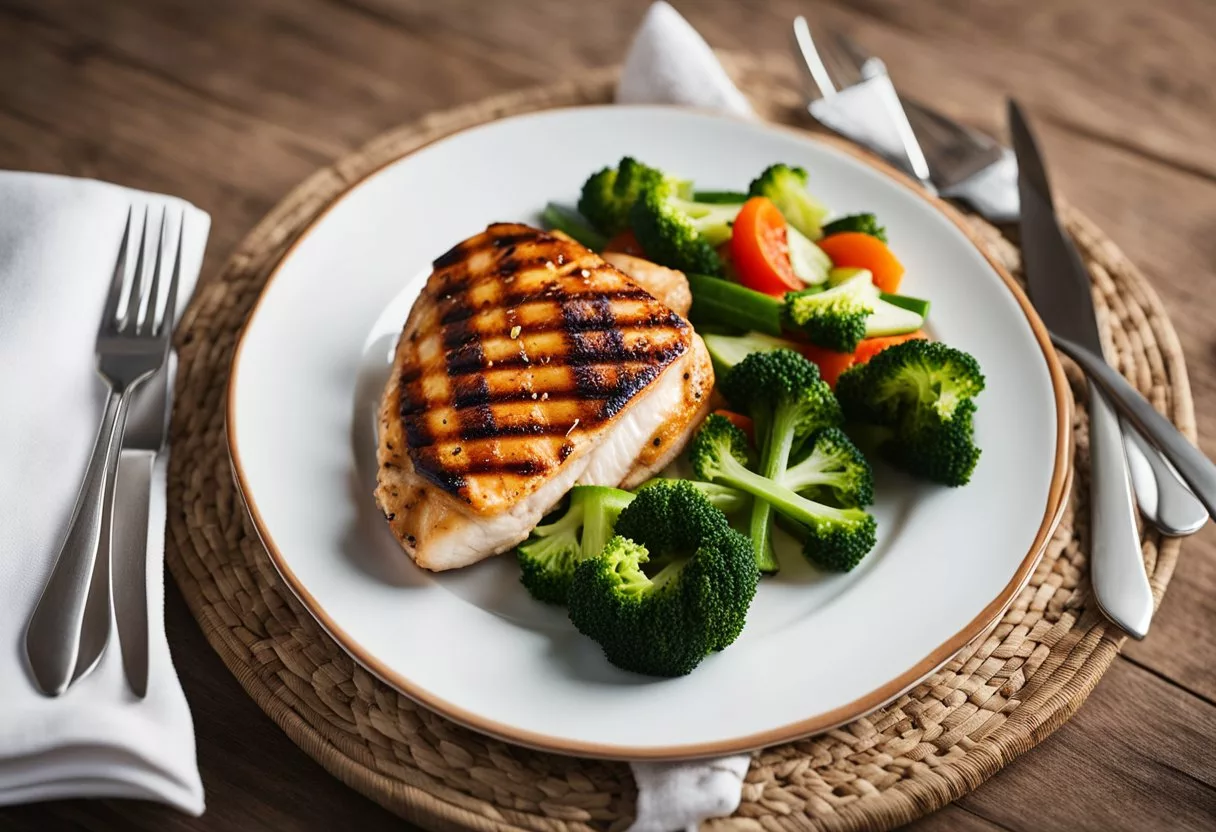
Different cooking methods can affect the calorie count of chicken breast. For example, while grilled chicken breast retains its low-calorie profile, frying it can increase the calorie content significantly due to added fats. For those wanting to keep their calorie intake low, poaching or baking are recommended.
Chicken breast isn’t just versatile in cooking methods but also beneficial for health. It’s low in saturated fat and rich in essential vitamins and minerals. For those who want to make the most out of their meal plans, chicken breast can be a staple for a nutrient-packed diet.
Key Takeaways
- A 120g chicken breast has about 198 calories.
- Cooking methods affect calorie content; grilled is leaner than fried.
- Chicken breast is high in protein and low in saturated fat.
Nutritional Profile
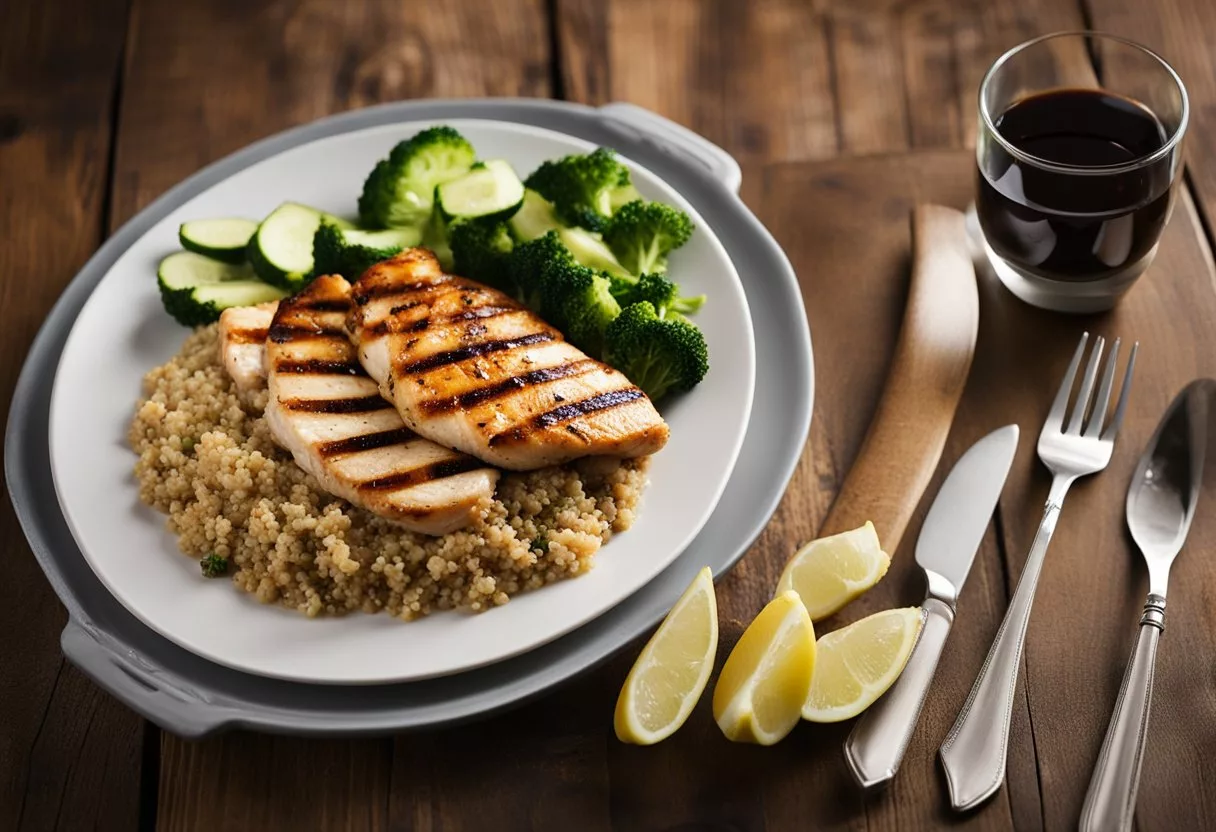
Chicken breast is a popular lean protein source, offering substantial nutritional benefits with minimal fat content. This section will outline the macronutrient breakdown, micronutrient content, and caloric content of chicken breast.
Macronutrient Breakdown
A 3-ounce (85 grams) serving of grilled, boneless, skinless chicken breast is rich in protein and low in fat. It contains 26 grams of protein and 2.7 grams of fat, making it an excellent source of lean protein. This serving has no carbohydrates, ensuring it’s suitable for low-carb diets.
The fat content is primarily composed of healthier fats, with very low levels of saturated and trans fats. Here is a quick breakdown:
- Saturated Fat: 0.9 grams
- Monounsaturated Fat: 1 gram
- Polyunsaturated Fat: 0.6 grams
Micronutrient Content
Chicken breast also provides various essential vitamins and minerals. Notably, it contains niacin (Vitamin B3), Vitamin B6, and Vitamin B12, which are important for energy metabolism and brain health.
In addition, it contains:
- Iron: 1.2 mg (7% of Daily Value)
- Calcium: 18 mg (1% DV)
- Sodium: 89 mg (4% DV)
- Potassium: 332 mg (7% DV)
- Selenium: 25 mcg (its importance in antioxidant functions)
- Phosphorus: 196 mg (roughly 20% DV)
- Zinc and Vitamin D (<1% DV each)
Caloric Content
The caloric content of a standard serving of chicken breast is modest, aligning well with weight loss and muscle-building diets. A 3-ounce (85g) serving has 128 calories.
Given its low-calorie and high-protein nature, chicken breast fits well into calorie-controlled and high-protein eating plans. Chicken also has zero sugars and no dietary fibers, focusing entirely on the delivery of protein with minimal impact on blood sugar levels.
Health Impact
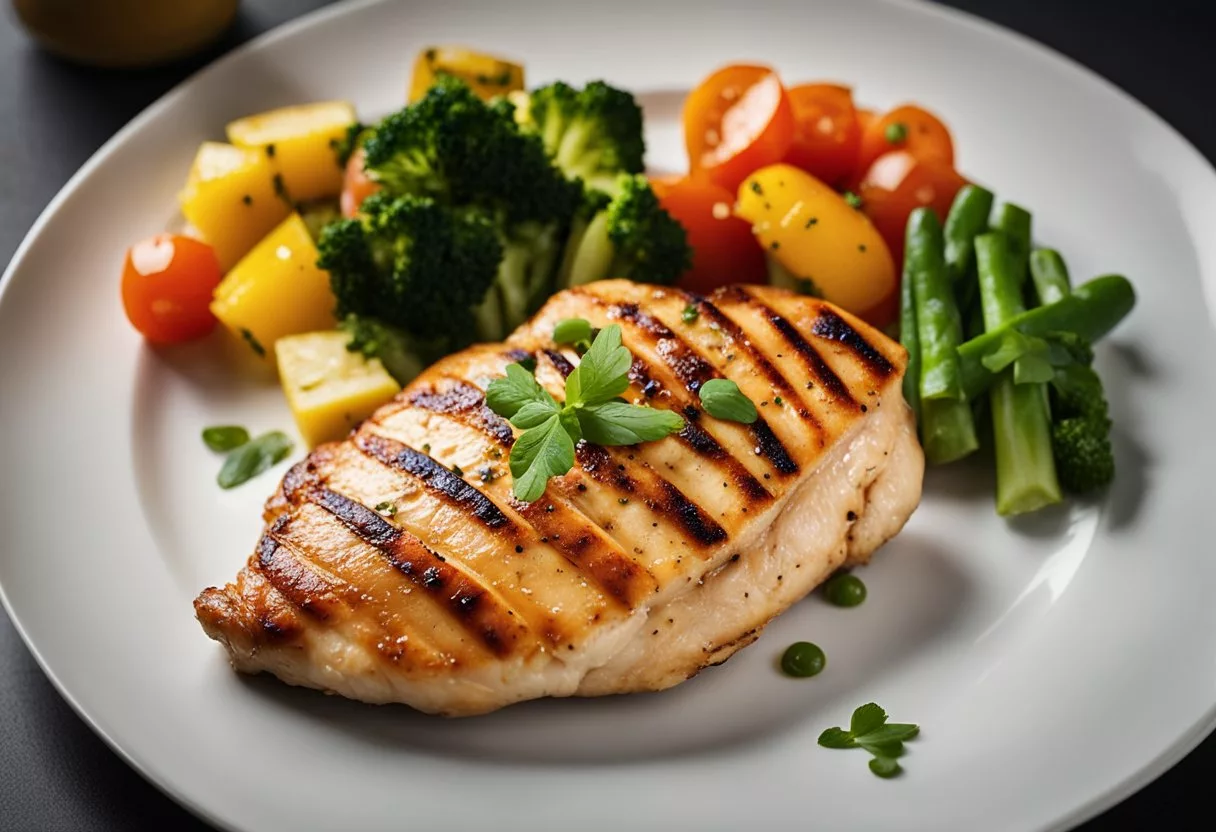
Chicken breast, with its high protein and low fat content, plays a significant role in various aspects of health. Its impact on weight management, muscle building, and cardiovascular health can be profound.
Weight Management
Chicken breast can be a valuable asset for those aiming to manage their weight effectively. It is a lean protein source with about 128 calories[1] per 3-ounce serving. This low-calorie content allows individuals to stay within their calorie limits.
High protein levels help in feeling fuller longer, reducing the urge to snack between meals. The absence of carbohydrates means fewer blood sugar spikes. Lean protein also requires more energy (calories) to digest, further aiding weight loss efforts.
Muscle Building
The high protein content in chicken breast makes it ideal for muscle building. Each 3-ounce portion provides about 26 grams of protein[2]. Protein is essential for muscle repair and growth, especially after intense workouts.
Chicken breast also contains essential amino acids, which are the building blocks of muscle tissue. Including chicken breast in a diet regimen helps in meeting daily protein needs and supporting muscle hypertrophy. This is crucial for athletes and bodybuilders.
Cardiovascular Health
Chicken breast can benefit cardiovascular health due to its low levels of saturated and trans fats. Consuming foods low in saturated fats helps reduce LDL cholesterol, which can lower heart disease risk. A 3-ounce serving of grilled, skinless chicken breast has only 2.7 grams of fat[1], making it a heart-friendly choice.
Replacing red meat with chicken breast in meals can further improve cholesterol profiles. Additionally, chicken breast contains other nutrients like vitamin B6, which supports heart health by helping in the formation of red blood cells and maintaining normal brain function.
By incorporating chicken breast into the diet, it is possible to support weight management, muscle growth, and heart health with ease and efficiency.
Chicken Breast Varieties

Different types of chicken breast offer varying nutritional benefits. Key differences are seen between chicken breast with skin and skinless, as well as between organic and conventional varieties.
With Skin vs. Skinless
Chicken breasts can be purchased with skin or skinless. A chicken breast with skin contains more fat and calories due to the presence of the skin. For example, a serving of chicken breast with skin contains 193 calories and 7.6 grams of fat. The skin adds flavor and moisture but also increases the total fat content.
On the other hand, a skinless chicken breast is lower in both fat and calories. A 3-ounce (85g) serving of grilled, boneless, skinless chicken breast has 128 calories and 2.7 grams of fat. This makes skinless chicken breast a popular choice for those looking to reduce their fat intake and increase protein.
Organic and Conventional
Organic chicken breasts come from chickens that are raised without antibiotics and hormones. These birds are often fed organic feed and are raised in conditions that allow more natural behaviors. This can result in a slightly different taste and texture compared to conventional chicken. Organic chicken tends to be more expensive but is preferred by those who prioritize animal welfare and avoid chemicals in their food.
Conventional chicken breasts are more commonly available and typically cheaper. These birds may be raised with antibiotics and hormones to promote growth. While these practices help keep costs down, they also raise concerns for some regarding potential health effects of consuming such products. Both types offer similar nutritional profiles in terms of protein and calories.
Cooking Methods

Cooking methods can significantly affect the calorie content of chicken breast. Understanding these methods is crucial for making healthier dietary choices.
Dry Heat Cooking
Dry heat cooking involves using hot air or direct heat without adding liquids. Techniques include grilling, roasting, and broiling. Grilling a chicken breast can help reduce fat since excess fats drip off. A grilled chicken breast[3] typically has fewer calories compared to other cooking methods, especially when skinless.
When roasting chicken breast, it’s important to use minimal oil to keep the calorie count low. Adding herbs and spices can enhance flavor without extra calories. Broiling uses direct heat from above, which can similarly lower fat content but requires careful monitoring to avoid overcooking.
Moist Heat Cooking
Moist heat cooking involves water, broth, or another liquid to cook the chicken. Techniques include poaching, boiling, and steaming. These methods usually add no extra fat, making them healthier options.
Poaching involves simmering the chicken in water or broth, which keeps it moist and tender. Boiling is similar but includes higher heat and direct water immersion. Both methods help maintain the chicken’s moisture and offer a low-calorie option.
Steaming cooks the chicken using steam from boiling water beneath it. This keeps the chicken juicy without adding any fat.
Frying and Breading
Frying and breading methods typically add more calories to the chicken. Techniques include pan-frying, deep-frying, and using a batter or breading. When pan-frying, chicken is cooked in a small amount of oil which increases its calorie content. Using healthier oils like olive or avocado oil can make it slightly healthier but still higher in calories.
Deep-frying submerges the chicken in oil, significantly raising calorie and fat content. Finally, coating chicken in batter or bread crumbs before frying adds extra carbs and calories.
Using these methods sparingly and opting for healthier oils can help reduce the negative impacts on calorie count.
Serving Suggestions
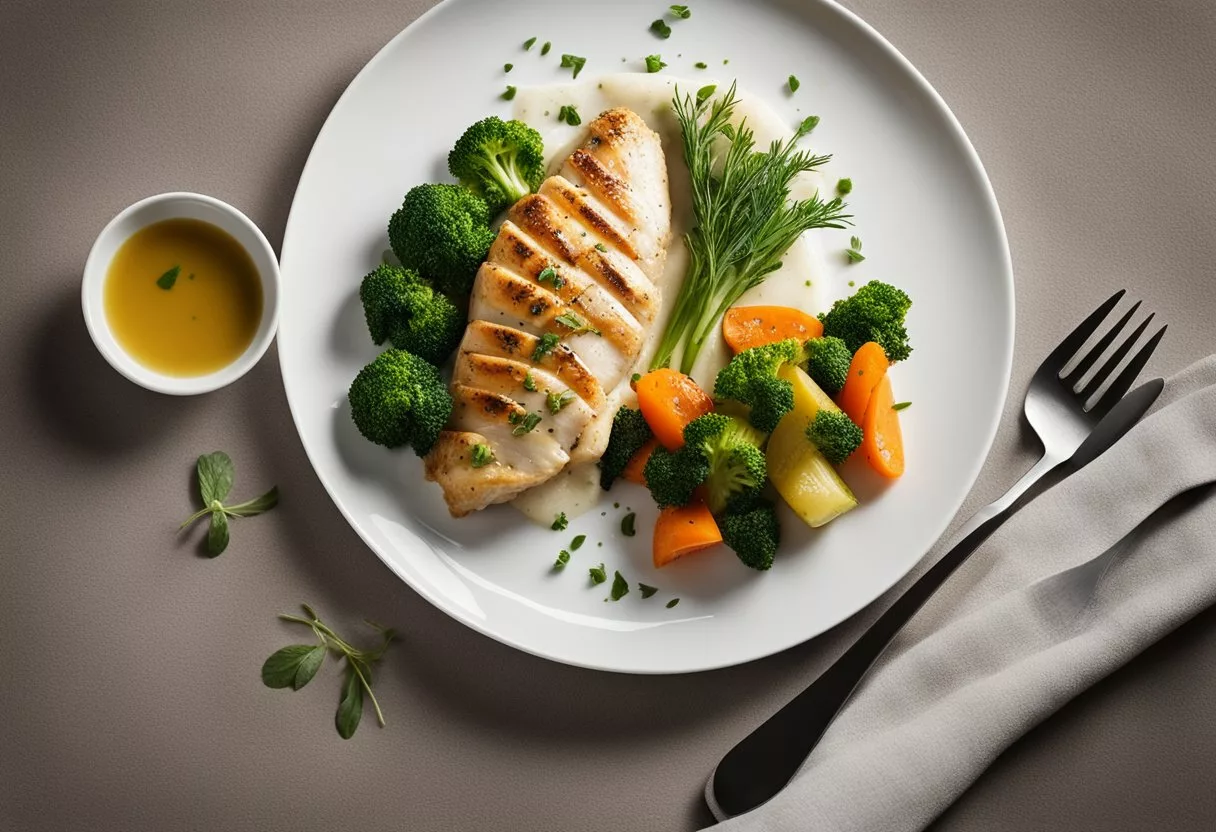
Chicken breast is versatile and can be prepared in many ways, such as grilled, roasted, or baked. Pairing it with nutritious sides and keeping an eye on portion sizes can enhance its benefits.
Healthy Pairings
Grilled chicken breast pairs well with a variety of vegetables. For instance, steamed broccoli, carrots, and asparagus add color and nutrition to your plate. A serving of chicken breast with leafy greens like spinach or kale can boost your intake of vitamins and minerals.
Whole grains like quinoa, brown rice, and farro are great complements. They provide fiber and help you feel full longer. Try a slice of roasted sweet potato for a nutrient-rich side. Using simple, healthy sauces like lemon garlic or a light vinaigrette can add flavor without extra calories.
Portion Sizes
A proper serving size for chicken breast is about 3-4 ounces, which is roughly the size of a deck of cards. This size provides a good balance of protein and fats without excessive calories. For example, a 3-ounce grilled, boneless, skinless piece has about 26 grams of protein and 2.7 grams of fat[1].
Measuring portions ensures you stay within your daily nutritional goals. Remember, many commercially packaged chicken breasts are larger, so consider using a kitchen scale. Stick to recommended serving sizes to avoid overeating and support a balanced diet.
Additional Information
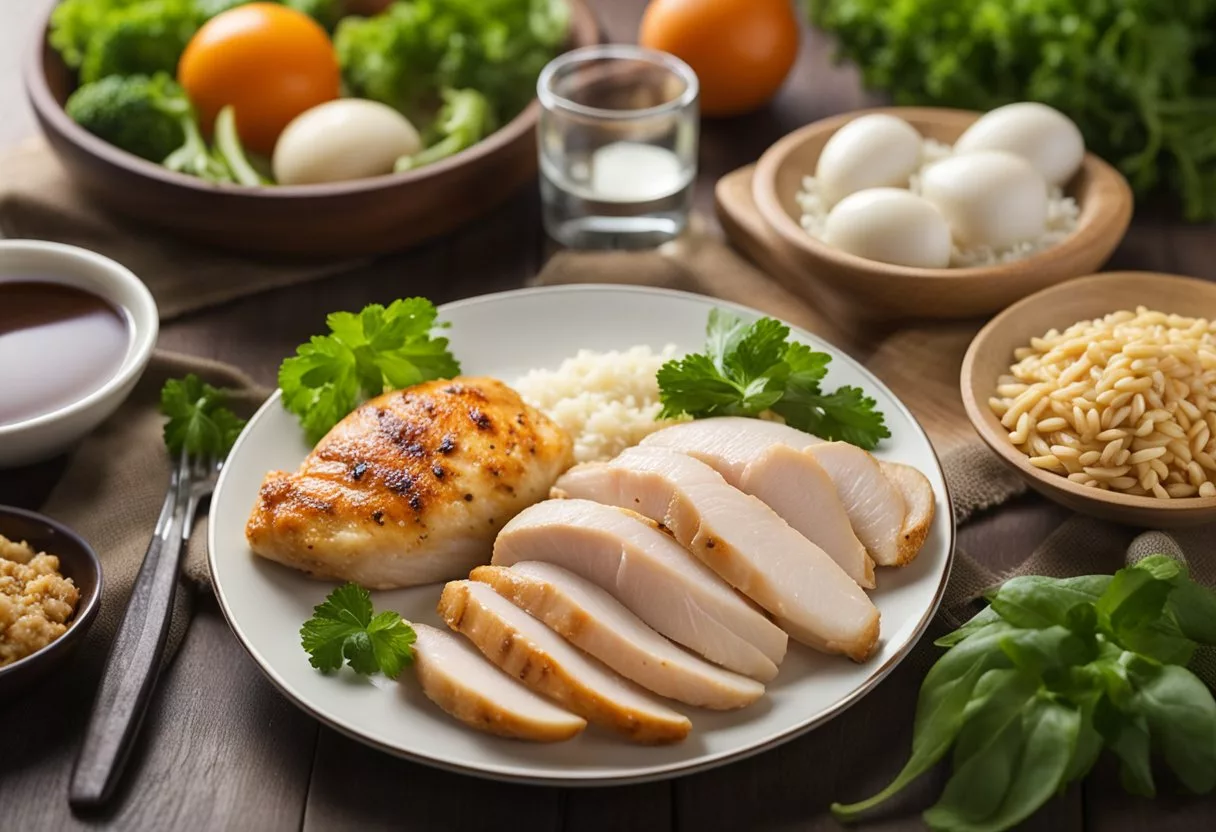
Understanding calories and nutritional values of chicken breast can help with meal planning. Label reading and using food data tools are key strategies for this.
Label Reading
Reading labels on chicken packaging gives important details about calories and other nutritional values. For example, a typical serving of boneless, skinless chicken breast often includes about 128 calories per 3-ounce (85g) piece. Labels provide information on protein, fat, and carbohydrates content.
Labels also show if any trademarks or copyrights, like those of Perdue, are present. Consumers can ensure they are choosing high-quality, reliably sourced chicken. Look for terms like “natural” or “organic” which may indicate fewer added preservatives.
Food Data Tools
Using online food data tools can further help track calorie intake. Websites such as FatSecret and Nutritionix offer detailed nutritional values. These tools often let users search through extensive food databases.
Calorie counters and food search features in these tools provide exact data. This helps in understanding how different preparation methods affect calories. For instance, 3.5 oz of grilled, boneless, skinless chicken breast has around 128 calories, but fried options can significantly increase this count (Greatist). These tools can help plan balanced diets with accurate information.
Frequently Asked Questions
Chicken breast is a popular, lean protein choice for many. Here are some key facts about the calorie and protein content of chicken breast in various serving sizes and preparations.
How many grams of protein are in a cooked 100g chicken breast?
A cooked, skinless chicken breast typically contains about 31 grams of protein per 100 grams. This makes it a great protein source for those looking to build muscle or maintain a high-protein diet.
What is the calorie count for a skinless chicken breast?
A skinless chicken breast has approximately 165 calories per 3.5-ounce (100-gram) serving. This makes it a low-calorie, high-protein food option.
How many calories are contained in an 8-ounce chicken breast?
An 8-ounce (about 227 grams) chicken breast provides roughly 376 calories. This serving size is often adequate for a full meal, balancing calorie intake and protein needs.
What are the calories in a 4-ounce portion of boneless skinless chicken breast?
A 4-ounce (113 grams) boneless, skinless chicken breast contains around 186 calories. This smaller portion can fit well into various meal plans, especially for calorie counters.
How many calories can be found in a 6-ounce portion of cooked chicken breast?
A 6-ounce (170 grams) cooked chicken breast has about 282 calories. This size is commonly used in meal prep and provides a substantial amount of protein and energy.
What is the calorie difference between boiled and grilled chicken breasts?
Boiled chicken breast typically retains fewer calories compared to grilled, mainly due to the absence of added fats during cooking. For example, boiled chicken breast may have around 165 calories per 3.5 ounces, while grilled chicken breast may vary slightly depending on added oils or seasonings used during grilling.
References
- 128 calories. https://www.verywellfit.com/how-many-calories-in-chicken-breast-3495665 Accessed October 27, 2025
- 26 grams of protein. https://www.health.com/chicken-benefits-7556373 Accessed October 27, 2025
- How Many Calories in Chicken? Breast, Thigh, Wing and More. https://www.healthline.com/nutrition/calories-in-chicken Accessed October 27, 2025
